I often think about virtual reality and the prospect of immersive experience of distant worlds using data returned by our probes. But what of the state of virtual reality today, a technology that is suddenly the talk of the computer world with the imminent release of the Oculus Rift device? Frank Taylor is just the man to ask. He has worked with computer graphics since the 1970s, starting at the University of Arizona. He worked several years at aerospace companies in support of DoD and NASA including simulation and virtual reality technology in support of astronaut training at NASA JSC. Frank has also been a successful entrepreneur doing work with Internet and other computer technologies. His most notable recent accomplishment was the completion of one orbit of the Earth at 0 MSL – he and his wife left in 2009 and sailed around the world arriving back in the US in 2015. Frank is the publisher of Google Earth Blog since 2005. Have a look now at the surprisingly wide possibilities already opening up for VR.
by Frank Taylor

For most of us reading Centauri Dreams, we have lived out our lives dreaming about travel to other stars and planets. Many of us have tried to satisfy our dreams vicariously by enabling the various unmanned missions to our non-terrestrial, solar system-based planets, Sun, moons, asteroids, and comets. Last summer, we were all captivated by watching the fly-by of our most distant planetary-like neighbor Pluto and its moon Charon.
In addition, we have over four centuries of both terrestrial and space-based telescopic observations to thank for our measured observations of both local and interstellar astronomical objects as far as our science has allowed. But, our hopes and plans of visiting other stars and planets for more direct observation has continued to elude us. For well known reasons documented here on Centauri Dreams.
Image: My friend Frank Taylor, photographed here on the Indian Ocean island of Reunion during his recent circumnavigation, which is fully documented (and with spectacular photography) on his Tahina Expedition site.
Computer Simulations of Space
As a career computer graphics scientist, I have been fortunate to simulate space-based operations for training astronauts, simulate remote tele-robotic space operations, and create animations depicting some of our in-orbit and planetary missions. I have also thoroughly documented the use of Google Earth for enumerable Earth depictions as well as involved in developing its use for other planets and moons in our solar system. I’ve published the Google Earth Blog since 2005 with almost daily news and stories about that program and its uses.
Going back to 1991, while working under contract with NASA JSC, I discovered a demonstration program on a Silicon Graphics workstation that was developed by an engineer named Erik Lindholm. It depicted a 3D simulation of the known local star systems, our entire solar system, and even had a few science fiction objects like Ring World around another star. The amazing thing was that you could travel between objects at speeds far exceeding known physics. Measurements were at multiples of C (speed of light). I was entranced by this experience of finally traveling to another star, and it wasn’t necessary to wait an unreasonable amount of real time to get there. For years afterwards, I wondered why someone had not ported the application to a wider audience (possibly less than 500 people saw that early one) – especially with the rapidly improving computer graphics capabilities of the typical desktop computer that decade.
In the 1990s, there were numerous planetarium applications that let you simulate the night sky, and some even let you visit other planets. But, it wasn’t until early 2001 that a real interstellar travel 3D simulator became popular. A program many of you may have heard of called Celestia (Wikipedia) was released and available for free. It mostly focused on the solar system, but also modeled a fair number of known star positions and compositions, and even allowed you to see an approximation of our galaxy and visit 3D versions of neighboring galaxies (but, not individual stars and planets).
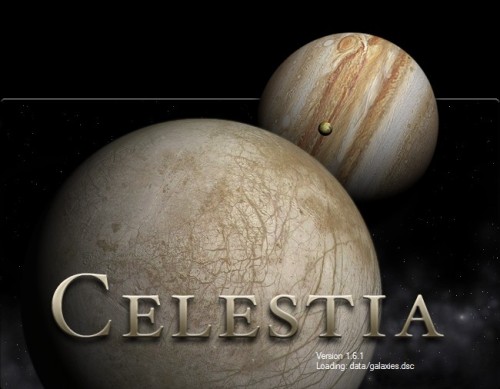
Image: Screenshot of Celestia loading data Version 1.6.1.
The developers ported Celestia to many operating systems (Windows, Mac, Linux, and even Amiga OS). An active community of fans contributed enhanced quality textures for planet surfaces, contributed ideas for educational tours, produced or converted 3D models of spacecraft (both real, design concepts, and fictional), and more.
For 10 years, Celestia was active. But, the developers stopped work by 2011. Celestia and community content is still available. Even if you have an older desktop or laptop, Celestia is likely to run well. Download Celestia here, and see the community content here. The caveat is that the graphics are based on older (circa 2000) generation products, and computer graphics cards have leaped ahead in quality in the last 15 years.
Current Generation Space Simulations
Recently, I was lamenting the lack of progress since Celestia, and discovered a link to an amazing Windows-based program called Space Engine (Wikipedia). This program is sure to make almost any astronomer, or Centauri Dreams fan, exclaim in awe and wonder for the opportunity to visualize and virtually experience interstellar destinations with almost artistic quality. Developed by a single programmer in Russia, whose name is Vladimir Romanyuk, with input from Russian astronomers and international scientists and fans, this program is amazing. In his own words Space Engine is described as:
“A free space simulation program that lets you explore the universe in three dimensions, from planet Earth to the most distant galaxies. Areas of the known universe are represented using actual astronomical data, while regions uncharted by astronomy are generated procedurally. Millions of galaxies, trillions of stars, countless planets – all available for exploration. You can land any planet, moon or asteroid and watch alien landscapes and celestial phenomena. You can even pilot starships and atmospheric shuttles.”
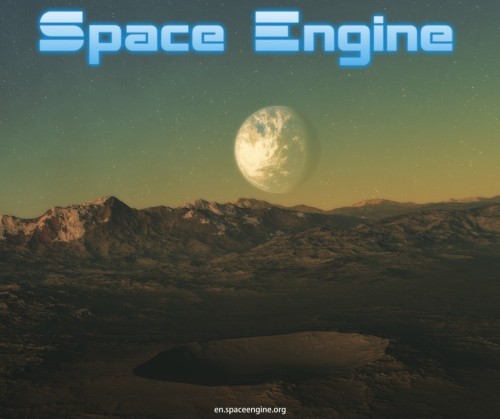
Image: Screenshot of Space Engine loading Version 0.9.7.4 showing moon terrain and atmosphere in orbit around oceanic planet.
Space Engine uses publicly available astronomical databases to represent the known stars and planets. Then he goes on to generate a suitable composition of remaining stars, star clusters, and nebulae for galaxies. Next, the program extrapolates planetary systems based on best guesses for physical compositions using orbital distances, star temperatures and types, and other factors. Planet classifications include gas giants, ringed worlds, desert planets, oceanic, ice, and more. Then he procedurally generates 3D terrain, and – when physically viable – water bodies, craters, mountains, canyons, volcanoes, and other terrain. The application then colorizes and adds textures to make the surfaces look realistic. Atmospheres are rendered, when present, including colorization based on physical composition and star colors. Space Engine even calculates whether life could be present on planets with the right characteristics. Also, a great deal of effort has been put into rendering black holes and accretion disks.
Here is a YouTube video by a fan reviewing an older version of Space Engine (by ObsidianAnt):
Video: A high resolution video showing samples of views in Space Engine with review commentary. Credit: YouTube, ObsidianAnt.
In attempt to make the program have a game-like feel, you can also add 3D space ships (including interstellar traveling ships) and actually fly them using a variety of supported controlling devices. Personally, I have plenty of fun just exploring stars and planetary systems without the spacecraft simulations. But, some readers here might have fun putting their favorite interstellar spacecraft designs into Space Engine.
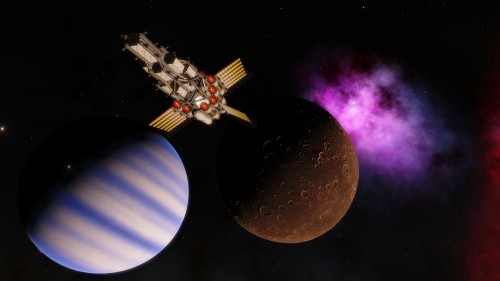
Image: Screenshot from Space Engine showing spacecraft in front of moon and gas giant with nebula in background.
Space Engine is available for free for Windows only right now, but you have to own (or have access) to a relatively recent desktop with recent high-end video card, or a high-end gaming laptop, to run this powerful program well. Recommended requirements are listed on the bottom of the home page for Space Engine. If you want to try it, the latest version can be found (in the forums) here. Vladimir is asking for donations to help fund further development and ports to Mac and Linux. I encourage those who enjoy the program to make a donation.
Space Engine attempts to be a mirror of the real universe as we know it. With the main exception being that travel times are greatly reduced. Would you believe there is yet another category getting even more development attention involving virtual interstellar travel?
Computer Games with Space Simulations
It is widely known that computer graphics’ rapid technological advancement in the past 40+ years was not solely due to scientific application pursuits. An even bigger factor has been the advancement and popularity of computer games. The same thing is happening to space-based simulations. There is an acceleration of interest in space-based games that is advancing the technology of space simulations. While Space Engine has been developing admirably during the past two years with a sole programmer of talented skills, a number of space games have been developed with modern gaming development budgets in the millions of dollars, and requiring dozens of game software engineers, artists, writers, physics modeling, simulation software, database engineers, and a business marketing budget equal to half the overall budget or more.
Some of these games involve interstellar travel and exploration and science fiction themes involving mostly commerce, and the inevitable gaming need of military action to protect interests. The typical gamer takes on jobs of space mining to build a fortune to acquire bigger and better space ships. Then they graduate to military ships and space battles ensue on a massive scale. For example, one massively online role playing game called Eve Online (Wikipedia) hosted last October a large scale space ship battle involving the loss of 1,165 ships (which equated to in monetary conversion to US $13,000) with 1600 gamers participating ( story here by Michael Bonnet, PC Gamer).
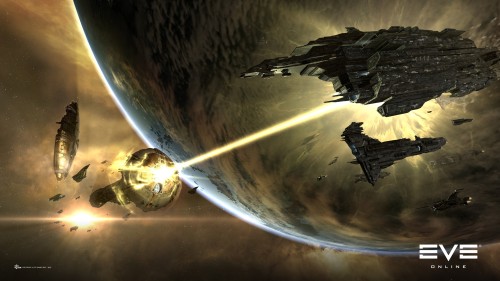
Image: Image of Eve Online orbital battle scene by CCP Games.
My interest lies in games that generate realistic visualizations of interstellar systems using spacecraft that we might build ourselves for exploration (if we can overcome the physics to get over the distance factors). The best space game simulation example I have seen is a game called Elite Dangerous (Wikipedia) by Frontier Developments based in Cambridge, UK. Frontier have created not only very realistic renderings of space and spacecraft, but have also added highly versatile surface recon vehicles (SRVs) that you can drive on the surface of planetary bodies (available in their latest season called Horizons).

Image: Image of Elite Dangerous – program developed by Frontier Developments Plc.
Elite Dangerous star systems and planets are quite well rendered in many ways similar to Space Engine. The graphics and lighting are astonishingly real, as is the physics of the simulations. Of course, because it is a game, situations can involve space battles with competing factions for space-based mining and other commercial operations. But, you can also just explore on your own as demonstrated in this YouTube video which shows a tour of our Solar System:
Video: A high resolution video showing a tour of a future version of our solar system from the game Elite Dangerous: Horizons. Credit: YouTube, ObsidianAnt.
Some of our planets have changed a bit due to human influences over the next thousand years of space development. You will note that fine simulation details such as the rendering of instrumentation on the pilot stations with working indicators of thrust, gravity, attitude, fuel, scanning of terrain when landing, and other ship and object conditions. Ships can be controlled with a number controllers such as those used for flight simulation, game controllers, or even mouse and keyboard.
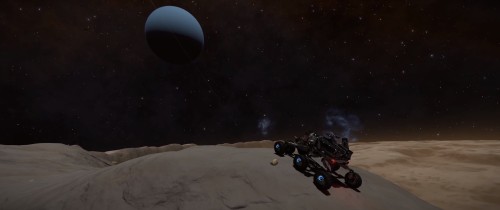
Image: Screenshot of rover on moon near planet in Elite Dangerous from YouTube video above by ObsidiantAnt.
As you can see, the budget of big games has resulted in an astonishing amount of simulation detail. You also may note that the video above was produced by the same person who created the video I shared for Space Engine. People who like the idea of interstellar travel gravitate their way to these similar space simulations.
The New Age of Virtual Reality
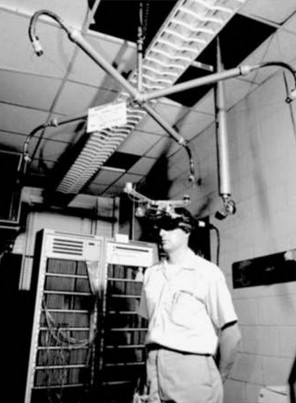
A major new influence of computer graphics is excitement surrounding the recent introduction of consumerized virtual reality technology. Virtual reality usually refers to immersive multimedia using computer simulation, accomplished through a head mounted display system representing stereoscopic 3D, or other multimedia, display, renderings and stereo audio. The idea of virtual reality technology and its development go back nearly as far back as the first computer graphics. The first immersive display system was built by Ivan Sutherland in 1968. It involved a heavy suspended helmet system with an early development of miniaturized cathode ray tube displays. The system became known as “Sword of Damocles”.
Image: Photograph of first VR system designed by Ivan Sutherland in 1968. The system became known as “Sword of Damocles”. A head mounted three dimensional display”, Ivan Sutherland, 1968.
In the late 1980s excitement about virtual reality reached beyond the purview of computer graphics researchers. This happened when advances in 3D graphics machines, display systems, 3D positioning devices, and hand-tracking devices began enabling interaction and a sense of immersion.
Of personal interest was that NASA was quite involved in research in VR in the 1980s. NASA Ames Research Center formed the Virtual Environment Workstation (VIEW) lab and was headed by Scott Fisher. In the early 80s, I worked at NASA JSC on the space shuttle simulator computer graphics used for training the astronauts. In the late 1980s I was working with engineers in a robotics simulation lab at NASA Johnson Space Center and one project was a VR helmet system used initially for research in training astronauts for the Manned Maneuvering Unit (MMU) for space walks. Later (early 90s) this system was used for tele-robotic simulations I helped develop to explore controlling the robotic arms on the space station (which was still being designed at the time).
Science fiction books fed fuel to the VR fire, when William Gibson’s book Neuromancer (1984) introduced the term “cyberspace” in the early 80s. Later, Neal Stephenson published Snow Crash (1992) which popularized a concept of a virtual reality rendered universe, which he called the “Metaverse”, which humans could visit and be represented through an avatar in a 3D world with shared defined places.
Hype about VR became widespread in the technology industry first in the late 80s. Then gaming companies in the early 90s announced VR systems that could be used in the popular video arcades. A movie called The Lawnmower Man (1992, Wikipedia) helped introduce the concept of VR to an even wider audience. Probably the most popularized science fiction concept of virtual reality was introduced in the late 80s in the form of Star Trek: The Next Generation (TV series, 1987, Wikipedia) with the “holodeck”. Of course, the holodeck is still the ultimate dream of a lot of VR enthusiasts.
Unfortunately, the capabilities used by researchers involved in VR in the 80s and 90s used very expensive computer graphics workstations and display devices. And, the displays were very crude at about 320×240 resolution at best. It was not yet possible to create cost effective, or realistic-looking systems at that time. The resulting game VR systems were crude and underwhelming when they came to market. Companies investing in the technology lost a lot of money and the concept’s popularity waned. I actually left NASA in 1992 intending to form a VR company, but my business planning fortunately revealed the impending dilemma and I instead started an Internet company. The impact of the burst of VR hype in that period of time, reduced interest in investment of consumer VR for the next 20 years. Far longer than I, or many other people, would have believed.
In 2012, an enterprising 19-year-old VR fan by the name of Palmer Luckey introduced the concept of building a new head mounted display (HMD) system using the now much more advanced computer graphics capabilities of desktop computers. Advances in display systems for mobile phones made possible much higher resolution displays for VR in a more lightweight HMD.
Palmer Luckey’s idea was an example of impeccable timing. He formed a company called Oculus to build his first system to be called the Oculus Rift. Within months, his company introduced the idea of raising funding through the crowdfunding site Kickstarter. He already had a large following in the gaming community because of an association with the most revered computer graphics gaming guru John Carmack. His goal was to raise $250,000. The concept was so popular that the goal was reached within four hours, and ended up raising nearly 2.5 million dollars instead. Although most of the contributors were gamers, the applications of VR reach a far wider range. Possibly the largest is entertainment as 360 filming has become practical and is very impressive.
By the end of 2013, Oculus had raised $75 million dollars in investment, headed by the leading technology investment broker Andreesen Horowitz. In March of 2014, Mark Zuckerberg announced on Facebook that they would be acquiring Oculus for $2 billion. Needless to say, this greatly raised attention to VR.
Even with the resulting flood of money, it would take two years to prepare the first Oculus Rift for consumer sales. However, Oculus also worked with Samsung to introduce an HMD called GearVR that works with top-end Samsung smartphones as the display device for only $100. It became widely available to consumers in 2015. The first Oculus Rift became available for pre-order in early January 2016. The first units are scheduled for delivery March 28, 2016. The difference between the GearVR and the Rift are greater fidelity and performance of computer graphics, better visual optics and positional tracking, 3D controllers and more versatility with a multi-tasking operating system. A competitor to Oculus from HTC called Vive started pre-orders on February 29, 2016. It has the ability to stand up and move around, and has two 3D hand-controllers for interaction.
Despite the delayed delivery to consumers, Oculus has reportedly shipped 200,000 units of prototype Oculus Rift units worldwide to software developers since early 2014. Numerous software products, in particular games, have introduced support for the Oculus Rift (and other Head Mounted Displays which have since been announced by other companies). And, over $2 billion in addition investments have gone towards the ecosystem of new VR companies in the last two years alone. Top analysts are predicting huge forecasts for adoption, but it’s a little early to say what the reaction will be until the new consumer products are on the shelves and real software ships.
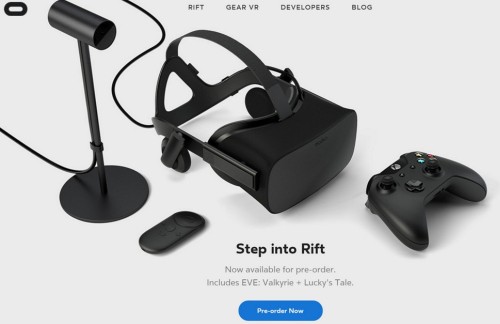
Image: Oculus Rift pre-order entry page January 6, 2016 with photo showing the components in the Oculus Rift package. First deliveries were scheduled for March 28, 2016.
VR in Space Simulations Today
Both Space Engine and Elite Dangerous have support for VR. In Space Engine, you can both gaze in wonder at the beauty of the universe, but also sense the scale and grandeur of nearby planets, moons, nebulae, and stars. While the system works well for Space Engine, the sense of immersion and 3D effects are much more pronounced in Elite Dangerous due to the primary placement being in the pilot seat of the space craft used for exploration. Stereoscopic 3D immersion is much more noticeable for objects in close proximity due to parallax. Hence the views are even more immersive in Elite Dangerous and the simulations of landing on a planet are quite exciting. Needless to say, these space-based experiences are very gratifying to me as a long-time believer in VR, especially with actual VR experience dating back to 1990.
Meanwhile, NASA and aerospace companies have continued to use VR for space simulations throughout the past 20 years. Some of the very same engineers I worked with in the early 90s started a VR Lab at JSC and have been using VR to train astronauts ever since (see article by Erin Carson at Tech Republic).
One of the most talked-about space VR programs is an educational story about the Apollo 11 mission to the moon. You can watch elements from launch to the historic moment when Armstrong steps on the moon. The in-development product has already won awards because of the strong emotional impact it has had on its viewers, and videos and demos are available for viewing in VR. You can watch a 360 video trailer of the Apollo 11 VR produced by Immersive VR Education out of Dublin, Ireland here (if you have cardboard you can watch it in 3D):
The new consumer space simulations software like Space Engine and Elite Dangerous are the closest most of us or going to get today to experiencing the exploring distant interstellar worlds and places. However, it should be noted that the requirements for the new consumer VR HMDs does have even higher system requirements for faster processors, memory, and video cards.
Interstellar researchers and exploration dreamers take note. Your chance for travel to the stars is virtually here.



I see virtual reality also been part of a long term voyage to remind them of home. I also see that this virtual reality been linked directly into the brain to give sensory impulses to make the experience more real.
VR is certainly a way to keep interstellar travelers occupied and stimulated in a closed environment, with limited potential of creative expression and experiences.
And the more realistic, the better. You want people to be as close as experiencing things impossible in the ship as possible.
So much in fact, that it has already been depicted in popular media, like in books (e.g. Greg Bear’s “Hull Zero Three”) and TV series (“Virtuality” series pilot).
I suppose the ultimate VR would be in a Matrix style environment on long voyages. It is funny that we dream of VR going interstellar and our future descendants will use it to remind them of home.
A new component to add to your VR :)
http://www.spacedaily.com/reports/High_G-force_training_system_on_way_for_fighter_pilots_999.html
A new version of Celestia, Celestia.Sci is currently being developed by the Celestial Matters team, apparently the code is close to being ready for public release, though a release of the application itself is still a way off.
Talking about VR, if you have a cardboard-like viewer, you might want to try this:
https://play.google.com/store/apps/details?id=com.software.mick.aaplus
https://itunes.apple.com/us/app/alien-apartement/id1048631676?mt=8
Of course VR is also the path to a solipsist Earth population, living in VR worlds rather than reality for much of their lives. Such a world would go dark on the cosmic stage, providing one answer to the Fermi question. I would hope humanity chooses reality, but the attraction of fictitious environments is known to be very attractive.
I agree completely with Alex Tolley, the Virtual reality trap. It may be centuries yet before space travel/exploration and colonization becomes a reality to the average person. The temptation to use VR in place of reality is already strong with some.
It’s the downside of the great Computer Age no one warned us about.
Personally, the chance to see the seemingly limitless variety and beauty of other worlds, and the chance to simulate what it would be like trying to land on them, only increases my desire to make it happen in real life. The same thing happened to me with flying. I flew flight simulators for years before I reached a point in my life where I could have the opportunity to learn to fly real planes.
As a thought experiment, imagine if flight simulators had been invented in 1000 AD. Would that have resulted in an earlier invention of flight, especially aircraft, or would it have stymied it as the technology would be so good that real flight would be forever considered inferior?
If we can believe technologists who say that SciFi books was a stimulus for their work (books being great simulator invokers in our brains) then it hopefully suggests flight would have been achieved earlier. Now whether star flight which is really hard can be similarly advanced, I don’t know. Hopefully teh answer is a resounding yes.
Could flight simulators be designed without information from real world experimentation? Our experience with virtual worlds shows a symbiotic relationship with real world experimentation and data gathering. A large population of VR consumers could very well increase the demand for new information. I have encountered several stories describing AI caretakers that scour the galaxy for new experiences to ‘feed’ their pluged-in wards.
I agree that VR worlds will play a role in humanity’s future and that VR worlds will become as immersive as what we see in “The Matrix”. It will be difficult to not develop the needed technologies and knowledge base for immersive VR as we develop the knowledge base for understanding the human brain. I think VR worlds will occupy the space now occupied my video games, movies, and most current electronic entertainment combined, but I don’t think it will 100% saturate the human experience.
Right, it’s a downside of the computer age. Why work hard to achieve something big when you can have an easy and cheap palliative? But that is like alcohol-free beer for former alcoholics. It’s not the real thing.
I don’t think that is it. It is more like a colonization wave. All these new and strange digital worlds to explore. Get bored with one try another. But ultimately the nwe and strange world may also be the old one. If everybody lives in VR the new and strange thing is to go into the real world, like an 80’s Retro Movement. I wouldn’t worry too much about it, its going to even itself out sooner or later. Also i am not so sure if achivements in games, especially with lots of participants, are really that easy to achive. Probably its most interesting if that isn’t the case. In my opinion we are still only at the very beginning of this WWW thing, which will profoundly impact our society.
Exactly my thoughts, and I’ ‘ve written it here in the Centauri- dreams- comments a few times I think. Theres you’re answer to the Fermi paradox. It will be just too easy to live out all your fantasies and dreams in the digital world ( you will be a “Golden God” in your own universe. Extremely vivid lucid dreaming but soooo much better) long before we will be able to do anything remotely interesting in the space exploration department. In a way a sad future, but will anyone really be sad? Don’t think so. The interesting thing is how the human brain will react to full 100% creative freedom. How will the brain evolve? Would it be like a total overload or the natural process of fantasy just made more accessible?
Does anyone know if there are any developments in VR for those of us who are blind in one eye?
Depth perception is totally lost in the stationary frame, but maybe someone could get it to work in VR for us.
As a very visually oriented person who nearly lost an eye due to an infection, and was temporarily blind for over year in that eye, I have a lot of sympathy with your problem. Unfortunately without parallax, I don’t think much can be done for depth perception except for motion. I found I could quickly grasp depth in 3D computer scenes as long as there was motion, and when needing it in the physical world I would pause and shift my head a bit to more quickly judge depth. Fortunately, VR actually allows you to move your head and see the changes to the 3D scene which helps a lot.
So VR does not rely on “red” and “blue” filters to generate 3D like the 3D movies – which we cannot watch?
If that is the case then it would be great news as we could also enjoy VR.
In real life we use motion to get depth perception and it looks like we could get the same effect in VR.
On the other hand, the science fiction that would have viewed as ‘escapism’ a couple of generations ago is now seen as a kind of ‘thought leadership’ in regard to the possibilities we can now explore in terms of hard science and actual engineering. Perhaps the same is true of the virtual technologies – particularly when they can give as a unique perspective on large data sets of astronomical data and system performance to help us ‘imagineer’ the future. A lot depends on whether the virtual technology is attempting to provide a faithful model of the universe rather than a fantasy world without consideration of empirical facts.
Yes, the faithful models are certainly more appealing to those of us who want to make this happen in reality. Unfortunately, there are always compromises, based on limiting factors of technology and development time, for these space simulations. I’ve been particularly impressed with the accomplishments of Vladimir’s Space Engine. The scale and scope of his creation is impressive.
The one downside to SpaceEngine is that it’s a closed source project and the work of one man, and as such the development can be a bit eccentric. Vlad will put in work to generate stellar coronal effects (which are nice but not often visible), but he won’t update the clouds of tidally locked planets to fix the outdated “eyeball earth hurricane” effect. There is some mod support (for adding ships, planets, etc) but not so much for tweaking the engine to reflect current research.
One program not mentioned is Stellarium (http://www.stellarium.org/). It’s scope isn’t interstellar, but it does have the ability to show the sky from any point on Earth *or* any other body in our solar system. Planting yourself on Mercury’s north pole and speeding up time to watch the sun roll around the horizon (and pause, reverse, pause, resume near perihelion) can be fun.
Of course VR that allows near instantaneous travel through the Universe is kind of cheating in itself. I would like to recommend to anyone interested in space travel an experience of the most important thing in space travel, SPACE.
http://joshworth.com/dev/pixelspace/pixelspace_solarsystem.html
Make available a rainy afternoon or scorching day inside in the AC. Put on your favorite music and set down with beverage and snack of your choice. Scroll over to the scale and click on the starburst symbol near lower right of screen. This will set your velocity at light speed. See how long you are willing to put up with the, as presently understood, speed limit of the Universe.
IMHO this is one of the best illustrations ever of the challenge of space travel.
Also, have to say that Elite: Dangerous really brought home the size of the galaxy when I went on a little jaunt off to Sagittarius A*… getting there and back takes a while.
(And I’m still only about halfway to getting the Elite explorer rank…)
One omission in the realistic simulation of space flight is Orbiter. It contains realistic space ships as well as planets. http://orbit.medphys.ucl.ac.uk/
The next best thing to being there for most of us unfortunately.
A great and informative article, thanks Frank. I worked many years in both space and VR, and both are dear to my heart.
However, cyberspace isn’t a replacement for the real thing – manned space exploration. In “Innovation Starvation,” Neal Stephenson said that we as a society have stopped thinking big. Others noted that we wanted cities on the moon and what we got was 140 characters and cat pictures on Facebook. I look forward to space-themed immersive VR, but as a path to – rather than a replacement of – the real thing.
Good space-themed VR entertainment and edutainment, space games and films in VR, could ignite the enthusiasm of children and teens again like the best Golden Age science fiction, and some of those kids will end up working in space and doing big things.
Both NASA and ESA had plans for massively multi-user space-themed VR adventure games, but I think the projects have been canceled or stopped.
Even better, immersive VR could open interactive windows to real space. Imagine a VR-equipped moonbase that users on Earth can explore in real-time in VR, operate equipment, drive rovers. Like those black and white Apollo videos in the sixties, but in fully immersive HD VR and interactive. Wow! That would put imagination and sense of wonder on fire – but then we must take the headset off and think how to contribute to the real thing.
Giulio. I hope you are right about VR stimulating interest in spaceflight. However, as we have noted on this blog before, the current generation in the developed world is relatively uninterested in space, and that despite increasingly realistic tv shows and movies. The state of the SF market is also not exactly stellar.
My own 2 children, both young adults were not aware of the various probe encounters last year. It was particularly sad that my daughter had done a project on Pluto in middle school, and I thought she might be interested to see what Pluto really was like. No dice.
The space entrepreneurs today, like Elon Musk, don’t seem to be followed with the same interest, even fervor, as the airplane designers and aviators of the last century were.
I wonder if this reflects the state of our civilization.
The main problem, i guess, is an inspirational one. You can’t generate this by literature, movies and games alone. I was born 1976 and practically grew up in the wake of the atmosphere of the Apollo missions. This had a profound effect on the following decades and i grew up with that and somehow took it as given that effords would be followed up with the same determination. In many ways this from 1959 on till far into the 90s was indeed the finest hour for western society. But it wasn’t a given, something of a missed opportunitie and that drive and determination died a slowly, quiet and unmourned death.
Its a conceptional problem, for back then there were clear set and ambiutious goals. Today its a little this and that and sparse funding but no clearly defined plan, no set goals and without a plan things tend to fall apart, even if NASA doesn’t want to hear this. Zubrin’s Mars direct speech very much hits the nail on the spot.
IF you look at conepts from the 60s, those are in many respects much more advanced than anything we are doing in 2016. If you care to watch the kind of presentations they did back then on NTRs you realize very soon a distinct deficiency of serious will for advancing. Phasing out Space Shuttles without a replacement and using, of all things, old russian Boosters for the heavy lifing is not where we wanted to go.
Sure, an Elon Musk may be musing about his Colional Transporter for Mars, but it is just that: a dream of a private entrepreneur. There is no real backing behind it on a national or a global lvel as it should be. We should have completed this decades ago.
The only bit of silver lining i see currently is the finally proceeding James Webb Telescope which will be launched in 2018. Based on its findings it may have the potential to shake governments out of theit complacency. Kepler achived that to some degree, but we need more of this and in a form that is not only exciting astronomers.
@Sascha. I have always divided people depending on whether they were born before or after Apollo. There seems to be a divide in sensibility about space that those who experienced that event compared to those for whom it was historic.
I think that making space routine, and profitable, is more important than national goals. Commercial satellites confirm that for me. No matter what public sentiment is, private comsat business will continue because it makes economic sense. I would like to see that happen in other areas, so that the exploration events that catch the public eye can piggyback off developed technology, rather than develop everything from scratch.
Space has to be sustainable, not a series of public spectacles used as proxies for short term national goals.
I’ll cheer when there is a space hotel catering to well-heeled tourists with a reliable, low cost space transporter to get them there in comfort, trips around and onto the surface of the moon, while a few intrepid explorers are doing work on the Moon for science and profit.
I agree that there seems to be a divide between the pre and post Apollo generations.
It is with some sadness that I watched this BBC interview with Neil Armstrong https://www.youtube.com/watch?v=PtdcdxvNI1o .
At the end of the video he says that he is confident that we will have established permanently manned lunar scientific stations within his lifetime.
We appear a lot further away from that goal than we were in 1970. None of my children or their friends seem to have any interest in space related activities, apart from the “space drama” movies.
A commercial space industry is an important component for sure. But it is a poor choice for exploration itself. Yes, we got sattelites and transport to the ISS, but these niches are either concerned with providing services downward (not outward), being an offshoot from military development or are dependant on conditions being created so that commercial footing has a degree of security. Without the ISS there would be no commercial off-world transport, save for a few tourists willing to pay exorbitant ticket proces to look at Earth from leo. Somebody had to do the heavy lifting and establish a space station to transport cargo to. The expiration date for the ISS is 2024, already extended, after that the future for comercial transports is not clear. If we had established a moonbase on the other hand, continued transport orders could be ensured. Still that is only profitable for the comercial companies, somebody still has to pay building and transports to and from station, so we have a very thin window of economic viability in any case and only in the shadow of greater, non-economic projects. Somebody has to lead, not even tieing it to national interest. Optimally it has to be an international efford on a global scale. Exploration is initially not an economically sound decision. You need security for this and exploration is pretty much the antithesis of security. That being said, in the long run, after initial investments have been made, it can turn out very useful, indeed. I don’t want to bore any of you with comparisions to Christoph Kolumbus, but that is basically the situation we are facing today again. If a nice has been estblished in can lead in many ways to gold-rush scenarios, but a modus operandi has to be esblished first, for example a moonbase could harvest water for magnetohydrodynamic propulsion drives, serving as a launching pad, greatly reducing mass requirements for interplanetary missions, plus its a whole lot easier launching from the moon than launching from Earth is. Then we can talk about opening up the resources of the solar system to humanity. But somebody has to go there and establish the neccesary infrastructure to do so. Currently and quite traditionally most of the planetary efford goes into weapon and defence spending. The best we can hope for this spending is that it doesn’t make an impact, is not used in other words, because if we use it we only add to global misery. Its a recursive choice. We need to make the jump to invest in progress and improvement of our capabilities, not the destruction thereof. Viewed from this angle its a quite simple choice, that is the challenge we face in my opinion. If we could could convince global key players of this approach, life would be a lot easier, i guess.
You’ll need a third group to cater for those of us born during Apollo, rather than before/after ;)
I have been posting about Space Engine for quite a while. It is really a wonderful example what can be achieved by single enthusiastic individual with talent.
It has a lovely fan community and attracts people from other communities like ambient and psychill music fans.
A beautiful example what can be achieved with this program can been seen here:
https://www.youtube.com/watch?v=wLlz1s8EFiw
As to Celestia I think it is widely used by Orion’s Arm community which has been developing a fan made semi-hard SF vision of future world(spanning up to 10,000 years in the future IIRC). Worth checking out IMHO. Anders Sandberg who IIRC was mentioned couple of times here, was part of the project for some time.